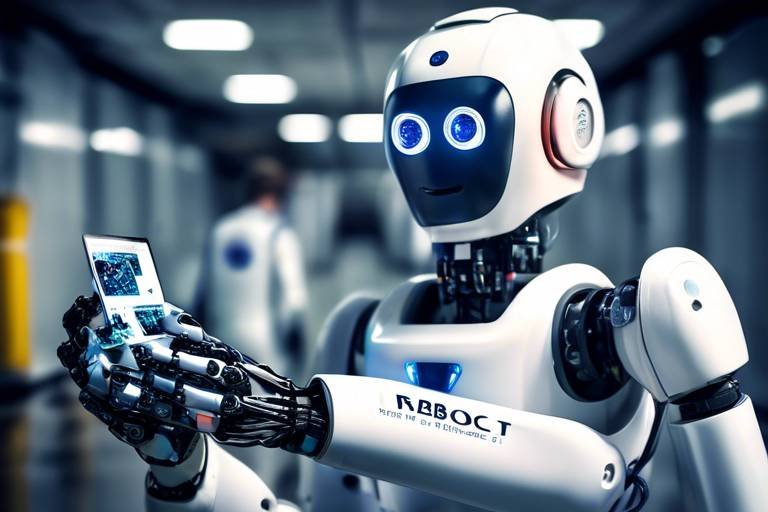How Robotics is Changing the Logistics Industry
The logistics industry is undergoing a radical transformation thanks to the advent of robotics. In an age where efficiency and speed are paramount, robotics provides a game-changing solution that not only streamlines operations but also enhances productivity. Imagine a bustling warehouse where robots are not just tools, but integral members of the team, working alongside humans to ensure that goods move swiftly and accurately from point A to point B. This is not science fiction; it’s the reality of modern logistics, where automation is reshaping the landscape.
As we dive deeper into this fascinating world, we’ll explore the various ways robotics is revolutionizing logistics. From autonomous mobile robots (AMRs) that navigate warehouses with ease to robotic process automation (RPA) that handles repetitive tasks, the impact of these technologies is profound. The future looks bright, but it also raises questions about workforce dynamics and the skills needed to thrive in an automated environment.
In this article, we will not only highlight the advancements in robotics but also discuss the challenges and opportunities they present. With automation at the helm, logistics companies are finding new ways to optimize their operations, reduce costs, and ultimately provide better service to their customers. So, buckle up as we embark on this journey through the world of robotics in logistics!
Automation is revolutionizing logistics by streamlining operations, reducing costs, and enhancing efficiency. The key drivers behind this rise include the need for faster delivery times, the demand for accuracy, and the increasing complexity of supply chains. In a world where consumers expect instant gratification, logistics companies are turning to automation as a way to meet these expectations.
Moreover, the ongoing labor shortages in many regions have forced companies to rethink their strategies. By implementing automated systems, they can maintain productivity levels even with fewer human workers. This shift not only addresses immediate challenges but also positions companies for long-term success in an increasingly competitive market.
Various types of robotics are employed in logistics, including autonomous mobile robots and robotic arms. Each category serves a specific purpose and plays a crucial role in enhancing logistics operations. Understanding these different types is essential to grasp how they contribute to the industry.
AMRs are transforming warehouse operations by navigating autonomously to transport goods. Equipped with advanced sensors and artificial intelligence, these robots can map their environment, avoid obstacles, and deliver items efficiently. Imagine a robot whizzing past you, seamlessly carrying a load of packages while you focus on other tasks. This is the future of warehousing.
The use of AMRs offers numerous advantages, such as:
- Improved Efficiency: AMRs can operate around the clock, significantly increasing throughput.
- Reduced Labor Costs: Fewer human workers are needed for mundane tasks, allowing them to focus on more complex responsibilities.
- Enhanced Safety: By taking over risky tasks, AMRs can reduce workplace accidents.
Despite their advantages, integrating AMRs into existing systems poses challenges. Companies often face:
- High Initial Costs: The investment needed for robotics can be substantial.
- Integration Issues: Existing logistics systems may require significant adjustments.
- Training Needs: Workers must be trained to operate alongside these new technologies.
RPA is another critical aspect of logistics robotics, automating repetitive tasks to enhance productivity. By using software robots to handle data entry, inventory management, and order processing, logistics companies can significantly reduce human error and free up employees for more strategic roles.
The introduction of robotics in logistics significantly affects workforce dynamics. As automation reshapes job roles, the skills required in the industry are evolving. While some positions may become obsolete, others will emerge, highlighting the need for a workforce that can adapt to technological advancements.
While robotics may displace certain jobs, it also creates new opportunities. The balance between job loss and new roles emerging from automation is crucial. For instance, roles in robotics maintenance, programming, and data analysis are on the rise, showcasing the need for a skilled workforce.
As robotics becomes more prevalent, workforce training is essential. Companies must invest in upskilling workers to adapt to new technologies in logistics. This not only benefits the employees but also ensures that companies remain competitive in a rapidly changing landscape.
Looking ahead, the future of robotics in logistics promises exciting advancements. Emerging trends such as machine learning, AI integration, and collaborative robots are set to shape the industry in the years to come. As these technologies continue to evolve, we can expect even greater efficiency, safety, and accuracy in logistics operations.
Q: Will robotics replace all human jobs in logistics?
A: While robotics will automate many tasks, they will also create new job opportunities, requiring a workforce skilled in technology and robotics.
Q: What skills will be most important in the future logistics workforce?
A: Skills in technology, data analysis, and robotics maintenance will be crucial as the industry continues to evolve.
Q: How can companies prepare for the integration of robotics?
A: Companies should invest in training programs and gradually implement robotics to ensure a smooth transition.

The Rise of Automation in Logistics
Automation is not just a buzzword; it's a game-changer in the logistics industry. As businesses strive to keep pace with the ever-increasing demand for faster and more efficient delivery services, the adoption of automated systems has become essential. But what exactly is driving this revolution? For starters, the need for cost reduction and efficiency enhancement plays a pivotal role. Companies are constantly looking for ways to streamline their operations, and automation provides a golden ticket to achieving that goal.
Imagine a world where goods are delivered to your doorstep in record time, all thanks to automated processes. This is not a distant dream; it’s happening right now! The logistics sector is embracing technologies like robotics, artificial intelligence (AI), and machine learning to optimize their supply chains. These technologies work together to not only speed up operations but also to reduce human error, which can be costly. In fact, studies show that automation can reduce operational costs by up to 30% in some cases.
Among the key drivers of this automation trend are the rising consumer expectations for faster deliveries and the increasing complexity of supply chains. Companies are now faced with the challenge of managing vast amounts of data while ensuring timely deliveries. This is where automation shines. By utilizing advanced algorithms and robotics, logistics providers can analyze data in real-time and make informed decisions that enhance overall performance.
Moreover, the impact of the COVID-19 pandemic cannot be overlooked. The sudden shift in consumer behavior, with a surge in online shopping, has forced logistics companies to adapt quickly. Many companies have turned to automation as a solution to cope with the heightened demand. For instance, the use of automated sorting systems has become more prevalent, enabling warehouses to process orders more efficiently than ever before.
However, it's not just about the technology; it's also about the people behind it. As automation becomes more widespread, organizations are investing in training programs to equip their workforce with the necessary skills to operate and maintain these advanced systems. This is an essential step because, without skilled personnel, the full potential of automation cannot be realized.
In summary, the rise of automation in logistics is driven by the need for efficiency, cost reduction, and the ability to meet evolving consumer demands. As we continue to embrace these technologies, the logistics landscape will transform dramatically, paving the way for a future where speed and accuracy are the norms rather than the exceptions. The question remains: are you ready to embrace this automated future?

Types of Robotics in Logistics
The logistics industry is undergoing a significant transformation, largely driven by the integration of various types of robotics. These innovations are not just enhancing efficiency but are also redefining how logistics operations are conducted. From autonomous mobile robots (AMRs) to robotic arms, the applications of robotics in logistics are diverse and impactful. Each type of robotic technology offers unique functionalities tailored to meet the specific needs of the industry. Let’s dive into the different categories of robotics and explore their applications in logistics.
Autonomous Mobile Robots, or AMRs, are at the forefront of this revolution. These robots are designed to navigate through complex environments, such as warehouses and distribution centers, without human intervention. They utilize advanced sensors and artificial intelligence to map their surroundings and make real-time decisions. Imagine a small robot zipping around a warehouse, effortlessly dodging obstacles while transporting goods from one location to another. This level of automation not only speeds up operations but also minimizes human error.
The advantages of deploying AMRs in logistics are substantial. For starters, they significantly improve operational efficiency. By automating the transportation of goods, companies can optimize their workflows, leading to faster order fulfillment. Additionally, AMRs help reduce labor costs, as fewer human workers are needed for repetitive tasks. A recent study indicated that companies using AMRs witnessed a 30% increase in productivity and a 25% reduction in operational costs. These robots can work around the clock, further enhancing productivity and ensuring that operations run smoothly, even during peak hours.
However, the integration of AMRs is not without its challenges. Companies often face obstacles such as high initial investment costs and the need for significant changes to existing infrastructure. Training staff to work alongside these robots is also crucial, as it requires a shift in mindset and operations. Furthermore, there can be technical issues, such as software glitches or hardware malfunctions, which can disrupt workflows. Despite these challenges, the long-term benefits of AMRs often outweigh the initial hurdles, making them a worthwhile investment for forward-thinking logistics companies.
Another critical aspect of robotics in logistics is Robotic Process Automation (RPA). RPA focuses on automating repetitive and rule-based tasks, which can significantly enhance productivity and accuracy. For instance, RPA can handle tasks such as data entry, inventory management, and order processing. By automating these mundane tasks, logistics companies can free up their human workforce to focus on more strategic activities that require critical thinking and creativity. This not only boosts morale but also drives innovation within the organization.
In summary, the types of robotics employed in logistics, particularly AMRs and RPA, are changing the face of the industry. While the benefits are clear, it’s essential for companies to carefully consider the challenges associated with their implementation. As the logistics landscape continues to evolve, embracing these robotic technologies will be crucial for staying competitive and meeting the demands of modern consumers.
- What are the main types of robotics used in logistics? The main types include Autonomous Mobile Robots (AMRs) and Robotic Process Automation (RPA).
- How do AMRs improve efficiency in logistics? AMRs automate the transportation of goods, reduce labor costs, and operate continuously, leading to faster order fulfillment.
- What challenges do companies face when implementing robotics? Common challenges include high initial costs, infrastructure changes, and the need for staff training.
- Can RPA replace human workers in logistics? While RPA automates repetitive tasks, it allows human workers to focus on more strategic roles, rather than replacing them entirely.

Autonomous Mobile Robots (AMRs)
Autonomous Mobile Robots, or AMRs, are at the forefront of innovation in the logistics sector, revolutionizing how goods are transported within warehouses and distribution centers. Imagine a bustling warehouse where robots glide effortlessly through aisles, picking up and delivering products without human intervention. This isn't science fiction; it's the reality of modern logistics, thanks to AMRs. These intelligent machines navigate their surroundings using a combination of sensors, cameras, and sophisticated algorithms, allowing them to avoid obstacles and optimize their routes in real-time.
One of the most remarkable features of AMRs is their ability to function in dynamic environments. Unlike traditional automated systems that require fixed paths or extensive infrastructure, AMRs can adapt to changing layouts and workflows. This flexibility is crucial in today’s fast-paced logistics landscape, where efficiency and speed are paramount. For instance, if a new shelf is added or a route is blocked, AMRs can quickly recalibrate their navigation plans without missing a beat.
But how do these robots actually operate? They rely on a combination of technologies, including:
- LiDAR (Light Detection and Ranging) for mapping and navigation
- Computer Vision for recognizing objects and avoiding obstacles
- Artificial Intelligence to learn and adapt to new environments over time
This sophisticated blend of technologies not only enhances the efficiency of logistics operations but also significantly reduces the risk of human error. By taking over repetitive and physically demanding tasks, AMRs allow human workers to focus on more strategic roles, thus enhancing overall productivity.
Moreover, the implementation of AMRs can lead to substantial cost savings for companies. With reduced reliance on manual labor, organizations can lower their operational costs while simultaneously increasing throughput. According to recent studies, businesses that have integrated AMRs into their logistics operations have reported up to a 30% increase in operational efficiency. This is a game-changer in a sector where margins can be razor-thin.
However, the journey to fully integrating AMRs into logistics is not without its challenges. Companies must consider factors such as initial investment costs, the need for robust infrastructure, and the integration of AMRs with existing warehouse management systems. Despite these hurdles, the long-term benefits of adopting AMRs are hard to ignore.
In conclusion, the rise of Autonomous Mobile Robots marks a significant shift in the logistics industry. As these robots continue to evolve, their potential to enhance efficiency, reduce costs, and transform workforce dynamics becomes increasingly evident. The future of logistics is not just about moving goods; it's about moving them smarter, faster, and more efficiently than ever before.
Q: What are Autonomous Mobile Robots (AMRs)?
AMRs are intelligent robots designed to navigate and transport goods within warehouses and distribution centers autonomously, using advanced sensors and algorithms.
Q: How do AMRs improve logistics efficiency?
They optimize routes, reduce human error, and allow for faster processing of goods, leading to increased throughput and cost savings for businesses.
Q: What challenges do companies face when implementing AMRs?
Challenges include initial investment costs, necessary infrastructure upgrades, and integration with existing systems.

Benefits of AMRs
Autonomous Mobile Robots (AMRs) are not just a trend; they are a game changer in the logistics sector. Imagine a bustling warehouse where goods are constantly being moved, sorted, and shipped. Now picture these tasks being handled by intelligent robots that can navigate complex environments without human intervention. This is the reality that AMRs bring to the table. One of the most significant benefits of using AMRs is their ability to enhance operational efficiency. By automating the transportation of goods, AMRs reduce the time it takes to move items from one location to another, ultimately speeding up the entire logistics process.
Moreover, AMRs contribute to cost savings that can be substantial. Traditional logistics operations often require a large workforce to manage manual tasks, which can lead to high labor costs. With AMRs, companies can streamline their workforce, allowing human employees to focus on more complex tasks that require critical thinking and problem-solving skills. This shift not only reduces costs but also increases productivity across the board.
Another noteworthy advantage is the improved accuracy in inventory management. AMRs are equipped with advanced sensors and software that allow them to track and manage stock levels in real-time. This capability minimizes human error, which can lead to costly mistakes like overstocking or stockouts. Automated systems can provide precise data on inventory levels, ensuring that businesses can respond swiftly to fluctuations in demand.
Additionally, AMRs enhance workplace safety. In environments where heavy lifting and repetitive tasks are common, the risk of injury is always present. By delegating these tasks to robots, companies can significantly reduce the likelihood of workplace accidents, creating a safer environment for employees. The robots can handle heavy loads and navigate through tight spaces, something that would be challenging and potentially hazardous for human workers.
To summarize, the benefits of AMRs in logistics are numerous and impactful:
- Enhanced operational efficiency through faster transportation of goods.
- Cost savings by reducing labor expenses.
- Improved accuracy in inventory management, leading to better decision-making.
- Increased workplace safety by minimizing the risk of injury.
As the logistics industry continues to embrace automation, the role of AMRs will only grow more significant. They are not just tools; they are partners in revolutionizing how logistics operations are conducted, paving the way for a more efficient and safer future.
Q: What are Autonomous Mobile Robots (AMRs)?
A: AMRs are robots designed to navigate and transport goods autonomously within a warehouse or logistics environment, using advanced sensors and software.
Q: How do AMRs improve efficiency in logistics?
A: By automating the transportation of goods, AMRs reduce the time required for moving items, allowing for faster processing and shipping.
Q: Are AMRs safe to use in warehouses?
A: Yes, AMRs are designed with safety features to navigate around humans and obstacles, significantly reducing the risk of workplace accidents.
Q: Will AMRs replace human workers?
A: While AMRs may take over certain repetitive tasks, they also create new opportunities for workers to engage in more complex roles that require human skills.

Challenges of Implementing AMRs
While the advantages of Autonomous Mobile Robots (AMRs) in logistics are clear, the journey to their successful implementation is not without its hurdles. One of the primary challenges is the integration with existing systems. Many companies have established workflows and technologies that are not designed to accommodate AMRs. This integration can require significant investment in both time and resources, as businesses must ensure that their current infrastructure can support these advanced machines.
Another significant challenge is safety concerns. AMRs operate in environments that are often busy and unpredictable, with human workers and other machinery constantly in motion. Ensuring the safety of all personnel while allowing AMRs to navigate freely is crucial. Companies need to invest in robust safety systems, which may include advanced sensors and real-time monitoring technologies, to prevent accidents and ensure smooth operations.
Furthermore, employee resistance can pose a significant barrier. Workers may fear job displacement or feel apprehensive about adapting to new technologies. This resistance can lead to a lack of cooperation, which is essential for the successful deployment of AMRs. To combat this, companies must engage in open communication with their employees, providing education about the benefits of AMRs and how they can complement human roles rather than replace them.
Additionally, the high initial costs of acquiring and implementing AMRs can be daunting for many businesses, especially smaller ones. While the long-term savings and efficiency gains can be substantial, the upfront investment can deter companies from making the leap into automation. It's essential for organizations to conduct thorough cost-benefit analyses to understand the potential return on investment before proceeding.
Lastly, technical limitations of current AMR technology can also be a stumbling block. While AMRs are becoming increasingly sophisticated, they still face challenges in navigating complex environments or handling certain types of goods. Continuous advancements in technology are necessary to overcome these limitations and enhance the capabilities of AMRs in logistics operations.
In summary, while the implementation of AMRs in logistics holds immense potential, companies must navigate a range of challenges, including integration with existing systems, safety concerns, employee resistance, high initial costs, and technical limitations. Addressing these issues head-on is crucial for businesses aiming to fully leverage the advantages that AMRs offer.
- What are Autonomous Mobile Robots (AMRs)? AMRs are robots that can navigate and operate in environments autonomously, transporting goods without human intervention.
- What are the main benefits of using AMRs in logistics? AMRs enhance efficiency, reduce labor costs, and improve accuracy in warehouse operations.
- What challenges do companies face when implementing AMRs? Key challenges include integration with existing systems, safety concerns, employee resistance, high initial costs, and technical limitations.
- How can businesses overcome employee resistance to AMRs? Open communication, education about the benefits of AMRs, and highlighting their role in complementing human tasks can help ease concerns.
- Are AMRs suitable for all types of logistics operations? While AMRs are versatile, their effectiveness can depend on the complexity of the environment and the types of goods being handled.

Robotic Process Automation (RPA)
Robotic Process Automation (RPA) is revolutionizing the logistics industry by automating repetitive and mundane tasks that once consumed valuable time and resources. Imagine a world where data entry, order processing, and inventory management are handled by intelligent software robots instead of human workers. This is not just a dream; it’s a reality that is reshaping the way logistics companies operate.
At its core, RPA utilizes software robots to mimic human actions and perform tasks across various applications. For instance, when a customer places an order, RPA can automatically pull data from the order form, update inventory levels, and even send confirmation emails—all without human intervention. This not only speeds up the process but also minimizes the risk of human error, which can lead to costly mistakes.
The benefits of implementing RPA in logistics are immense. Companies can achieve significant cost savings by reducing the need for manual labor in repetitive tasks. Furthermore, RPA enhances productivity by allowing human workers to focus on more strategic and creative tasks, rather than getting bogged down in routine work. According to recent studies, companies that adopt RPA can see efficiency gains of up to 30% in their operations.
However, like any technology, RPA comes with its own set of challenges. Integrating RPA into existing systems can be complex. It requires a well-thought-out strategy and a clear understanding of the processes that can be automated. Additionally, companies must ensure that their workforce is prepared for this shift. Training and upskilling employees to work alongside RPA technologies is crucial for a successful transition.
To give you a clearer picture of how RPA is being utilized in logistics, let’s look at some common applications:
- Order Processing: Automating the order fulfillment process from start to finish.
- Inventory Management: Keeping track of stock levels and automatically reordering supplies as needed.
- Shipping Documentation: Generating and managing shipping labels and documents efficiently.
- Customer Service: Handling inquiries and updating customers on their order status through automated responses.
As we move forward, the role of RPA in logistics will only expand. With advancements in artificial intelligence and machine learning, these software robots will become even more sophisticated, capable of handling more complex tasks and making decisions based on data analysis. This evolution will further enhance operational efficiency and allow logistics companies to stay competitive in an ever-changing market.
In conclusion, Robotic Process Automation is not just a trend; it’s a fundamental shift in how logistics operations are conducted. By embracing RPA, companies can streamline their processes, reduce costs, and ultimately provide better service to their customers. The future of logistics is bright, and RPA is leading the charge.

Impact on Workforce Dynamics
The introduction of robotics into the logistics industry is not just a technological shift; it's a seismic change that ripples through workforce dynamics. As robots take on more tasks, from sorting packages to driving forklifts, the roles of human workers are evolving dramatically. This transformation raises a plethora of questions. How will these changes affect job security? What new skills will workers need to thrive in an increasingly automated environment? The reality is that while some jobs may become obsolete, new opportunities are also emerging, creating a complex landscape of job displacement and creation.
One of the most significant impacts of robotics is the shift in job roles. Traditional roles that involved manual labor are gradually being replaced by positions that require a different skill set. For instance, warehouse workers may find themselves transitioning into roles that involve overseeing robotic systems or managing automated processes. This shift necessitates a change in mindset; rather than viewing robots as threats, workers are encouraged to see them as tools that can enhance productivity and efficiency.
Moreover, the integration of robotics into logistics operations demands a reevaluation of the skills required in the workforce. As robotic technologies become more sophisticated, the need for workers who can operate, maintain, and program these machines becomes paramount. Companies are investing in training programs to upskill their workforce, ensuring that employees are equipped to handle the demands of a tech-driven environment. This emphasis on skills development is crucial, as it not only prepares workers for the future but also fosters a culture of continuous learning and adaptation.
However, it’s important to acknowledge the challenges that come with this transition. Many workers may feel uncertain about their job security, fearing that automation will render their roles obsolete. To address these concerns, companies must engage in transparent communication and offer support during the transition. By fostering an environment where employees feel valued and informed, organizations can mitigate fears related to job loss and encourage a more positive outlook on the changes ahead.
In summary, the impact of robotics on workforce dynamics in the logistics industry is multifaceted. While there are valid concerns regarding job displacement, there are also exciting opportunities for growth and development. As logistics companies adapt to this new reality, the focus will need to be on reskilling and upskilling the workforce to embrace the future of work. This evolution will not only benefit the industry but also empower workers to thrive in an increasingly automated world.
- Will robots replace all human jobs in logistics?
No, while robots will take over certain tasks, they will also create new roles that require human oversight and management. - What skills will be most important in the future of logistics?
Skills in technology, data analysis, and robotics management will be crucial as the industry evolves. - How can workers prepare for the changes brought by robotics?
Workers can prepare by seeking training and education in technology-related fields and being open to continuous learning.

Job Displacement vs. Job Creation
The advent of robotics in the logistics industry has sparked a heated debate around the issue of job displacement versus job creation. On one hand, the automation of certain tasks can lead to the elimination of traditional roles. For instance, jobs that involve repetitive manual labor, such as picking and packing, are increasingly being performed by machines. This shift raises concerns among workers about job security and the potential for widespread unemployment. However, it’s essential to recognize that while some jobs may vanish, others are emerging in their place.
Consider this: as logistics companies adopt new technologies, they require a workforce equipped with different skills. This transition opens up opportunities in areas such as robot maintenance, programming, and data analysis. For example, a warehouse that once employed dozens of pickers might now need a smaller team of highly skilled technicians to oversee the robotic systems. Thus, the narrative isn't simply about loss but also about the evolution of job roles within the industry.
According to a recent study, while it’s estimated that up to 20% of jobs in logistics could be automated over the next decade, the same study predicts that over 30% of new jobs will require skills in technology and robotics. This means that the workforce must adapt to the changing landscape, and companies must invest in training and development programs to help their employees transition into these new roles.
Moreover, the integration of robotics can lead to increased productivity and efficiency, which can ultimately drive business growth. As companies expand, they may find themselves needing to hire more workers to support their operations, albeit in different capacities. The key takeaway is that while automation may displace certain roles, it simultaneously creates a demand for new skill sets, leading to a transformation rather than a complete eradication of jobs.
In summary, the relationship between robotics and employment in logistics is complex. It’s not simply a matter of robots taking jobs; rather, it’s about how the industry is evolving and what that means for the future workforce. Companies that embrace this change and focus on upskilling their employees will be better positioned to thrive in this new era of logistics.
- Will robots completely replace human workers in logistics?
While robots will automate many tasks, they will not completely replace human workers. Instead, they will change the nature of jobs, requiring new skills and roles. - What types of jobs are most at risk due to automation?
Jobs that involve repetitive and manual tasks, such as sorting and packing, are most at risk. However, new opportunities will arise in technology and maintenance roles. - How can workers prepare for the changes brought by robotics?
Workers can prepare by investing in education and training programs that focus on robotics, data analysis, and technology management. - Are there any benefits to robotics in logistics aside from job creation?
Yes, robotics can improve efficiency, reduce operational costs, and enhance safety in logistics operations.

Skills Development and Training
As robotics continues to revolutionize the logistics industry, the importance of cannot be overstated. With the rise of automation, many traditional roles are evolving, and new positions are emerging that require a different set of skills. This shift necessitates a proactive approach to workforce training, ensuring that employees are equipped to thrive in a technology-driven environment. Imagine a world where workers are not just passive recipients of technology but are actively engaged in its development and deployment. This is the future we are heading towards, and it’s exciting!
To keep pace with advancements in robotics, companies must invest in comprehensive training programs. These programs should focus on both technical skills, such as programming and operating robotic systems, and soft skills, like problem-solving and adaptability. The balance between these skill sets is crucial, as the logistics landscape becomes increasingly complex and dynamic. For instance, while a worker might need to understand how to operate an autonomous mobile robot (AMR), they also need to think critically about how to troubleshoot issues that may arise during operations.
Moreover, organizations should consider implementing ongoing training initiatives rather than one-time workshops. This could involve regular upskilling sessions, mentorship programs, and partnerships with educational institutions to create tailored courses that align with industry needs. By fostering a culture of continuous learning, companies can ensure their workforce remains relevant and competitive. After all, the logistics industry is not just about moving goods; it’s about leveraging technology to enhance efficiency and customer satisfaction.
Furthermore, it’s essential to recognize that training should be inclusive and accessible to all employees. This means developing programs that cater to various learning styles and backgrounds. For example, some employees may benefit from hands-on training, while others might prefer online courses or simulations. By providing diverse training options, organizations can maximize engagement and retention of knowledge.
In conclusion, as robotics takes center stage in logistics, investing in skills development and training is not merely an option; it’s a necessity. By equipping the workforce with the right tools and knowledge, companies position themselves for success in a rapidly changing landscape. The question isn’t whether robotics will change logistics but rather how prepared we are to embrace this change and lead the charge into the future.
- What skills are most important for workers in the logistics industry? Workers should focus on technical skills related to robotics, data analysis, and software proficiency, as well as soft skills like communication and problem-solving.
- How can companies ensure their training programs are effective? Companies can assess the effectiveness of training programs through employee feedback, performance metrics, and ongoing evaluations to adapt and improve the curriculum.
- Is robotics training only for technical staff? No, all employees can benefit from understanding robotics, as it impacts various roles within the logistics chain.

The Future of Robotics in Logistics
The future of robotics in logistics is not just a glimpse into a distant horizon; it’s an exciting reality that is unfolding before our eyes. As we stand on the brink of a technological revolution, the logistics industry is poised to undergo profound changes driven by innovations in robotics and automation. Imagine a world where warehouses operate with minimal human intervention, where autonomous robots seamlessly navigate through aisles, picking and packing items with precision. This isn’t science fiction—it’s happening now, and it’s just the beginning.
One of the most significant trends shaping the future of logistics is the integration of artificial intelligence (AI) with robotics. AI empowers robots to learn and adapt to their environments, making them smarter and more efficient. For instance, by utilizing machine learning algorithms, robots can optimize their routes in real-time, reducing delivery times and minimizing operational costs. This combination of AI and robotics is set to enhance decision-making processes, allowing logistics companies to respond swiftly to market demands.
Moreover, the use of Internet of Things (IoT) technology will revolutionize how logistics operations are monitored and managed. With IoT devices, every aspect of the supply chain can be tracked in real-time, providing valuable data that can be analyzed to improve efficiency. Imagine a scenario where sensors on delivery trucks communicate with warehouses, ensuring that inventory levels are always optimized, and deliveries are perfectly timed. This level of connectivity will create a more agile and responsive logistics environment.
Another exciting development is the rise of collaborative robots, or cobots, which are designed to work alongside human workers. Unlike traditional robots that operate in isolation, cobots can assist in tasks such as sorting, packing, and even customer service. This human-robot collaboration not only enhances productivity but also allows companies to leverage the unique strengths of both humans and machines. The future logistics workforce will likely include a blend of human ingenuity and robotic efficiency, leading to a more harmonious work environment.
As we look ahead, sustainability will also play a crucial role in shaping the future of logistics robotics. Companies are increasingly recognizing the importance of reducing their carbon footprints and adopting eco-friendly practices. Robotics can contribute to this goal by optimizing delivery routes to minimize fuel consumption, automating recycling processes, and utilizing electric or hybrid vehicles for transportation. This commitment to sustainability will not only benefit the planet but also enhance the brand image of logistics companies in the eyes of environmentally conscious consumers.
In summary, the future of robotics in logistics is bright and filled with possibilities. From AI-driven innovations and IoT integration to collaborative robots and sustainable practices, the logistics industry is on the verge of a major transformation. As these technologies continue to evolve, they will not only enhance operational efficiency but also redefine the very essence of how goods are transported and delivered. The question is not whether these changes will happen, but rather how quickly they will reshape the logistics landscape.
- What are autonomous mobile robots (AMRs) used for in logistics?
AMRs are used to navigate warehouses and transport goods without human intervention, significantly improving efficiency and reducing labor costs. - How does AI enhance robotics in logistics?
AI enables robots to learn from their environment, optimize routes, and make real-time decisions, enhancing overall operational efficiency. - What role do collaborative robots play in the logistics industry?
Collaborative robots work alongside human workers, assisting in various tasks and improving productivity while maintaining a safe working environment. - How can logistics companies ensure sustainability through robotics?
Logistics companies can adopt eco-friendly practices by optimizing delivery routes, automating recycling processes, and using electric vehicles, all supported by robotic technology.
Frequently Asked Questions
- What is the role of robotics in the logistics industry?
Robotics plays a crucial role in transforming logistics by automating various processes, which enhances efficiency, reduces operational costs, and streamlines supply chain management. From autonomous mobile robots (AMRs) that transport goods to robotic arms that handle packaging, robotics is reshaping how logistics companies operate.
- How do Autonomous Mobile Robots (AMRs) improve warehouse operations?
AMRs navigate through warehouses autonomously, transporting goods without human intervention. This not only speeds up the movement of products but also minimizes the risk of human error. By optimizing routes and reducing labor-intensive tasks, AMRs significantly boost overall warehouse efficiency.
- What are the challenges of implementing robotics in logistics?
While the benefits are clear, integrating robotics into existing logistics systems can be challenging. Common obstacles include high initial costs, the need for infrastructure upgrades, and resistance from employees concerned about job security. Companies must carefully plan their implementation strategies to address these challenges.
- Will robotics lead to job loss in the logistics sector?
It's a complex issue. While robotics may displace certain manual jobs, it also creates new opportunities in areas like robotics maintenance, programming, and system management. The key is to focus on reskilling and upskilling the workforce to adapt to these changes.
- How important is training for workers in a robotics-driven logistics environment?
Training is essential as the logistics industry evolves with robotics. Workers need to develop new skills to operate and maintain advanced robotic systems. Investing in training programs not only helps employees adapt but also enhances productivity and job satisfaction.
- What does the future hold for robotics in logistics?
The future of robotics in logistics looks promising, with advancements in artificial intelligence, machine learning, and automation technologies on the horizon. We can expect more sophisticated robots that can handle complex tasks, further optimizing logistics operations and improving service delivery.


















